Pain is the common condition for which health care advice is taken. Public awareness about health care and self treatment of pain is increasing. Analgesics are the most common self prescribed drugs [1,2].
Analgesics are considered to be relatively safe drugs. However, if we see the quantum of use in public at large and in high risk population; they are not free of side effects. Side effects are often seen when these drugs are used for prolonged period or in high doses or used where contraindicated. These adverse effects are gastrointestinal, cardiovascular, renal and hepatic [3-6].
Studies show that a significant number of people using these self-prescribed drugs are not aware of the associated side effects [7]. Also, more than 50% of the pharmacists are not able to guide the patients regarding safe use of self prescribed drugs as observed in a study done in patients with headache [8].
Improper and irrational use of these drugs can lead to increase in morbidity, mortality, misuse of healthcare resources and increased health care cost [9,10].
Since, ample amount of information about safe use of analgesics is available on the web, it’s important to explore its role in educating the population regarding the use of self prescribed medicines including analgesics.
Hence, we planned a study to explore pattern of analgesic use, to identify population at risk of developing side effects related to analgesic use, awareness of side effects and potential role of internet to bring awareness about safe use of self prescribed analgesic drugs in a rural area of Delhi.
Materials and Methods
A cross-sectional survey based study was done at Hamdard Institute of Medical sciences and research between June 2016 and July 2016. The study was conducted on 500 adults in the age group of 18-65 years of Madanpur Khadar area of South Delhi, India, coming to the pharmacy shop to purchase self-prescribed analgesic drugs (acetaminophen, aspirin, other NSAIDs like ibuprofen, diclofenac, naproxen, nimusulide, celecoxib etc., and opioids like tramadol, codeine).
All the consenting individuals in the age group of 18-65 years were included in the study.
Health professionals (doctors, pharmacist, nurses, etc.,) and their family members, individuals with emotional, psychiatric and intellectual disturbances, that could affect the reliability of their responses were excluded from the study.
The data collection was started after approval of the study proposal by the Institutional Ethical Committee (Jamia Hamdard University). Data collection was done by conducting visits to pharmacy shops from the people who were buying drugs without prescription and taking face to face interviews using a semi-structured questionnaire using 20 questions. The questionnaire was designed by group of anaesthesiologists and pharmacology department. Validation was done by members from pharmacology and community medicine. The questionnaire consisted of four sections:
Section 1- personal and demographic details of the buyer;
Section 2- information regarding drug usage and self prescription;
Section 3- information regarding the sources of information on self medication and adverse effects;
Section 4- ability to use mobile/internet/social media.
Physical visits were made to a total of 25 pharmacy shops located in this area.
The pharmacy shops were visited twice in a day (one hour in the morning and one hour in the evening) and 20 subjects were interviewed from each pharmacy shop. Objectives and procedure of the study was explained to the subjects buying analgesics without prescription in their own language. The interview was taken and simultaneously the questionnaire was filled by the investigator corresponding to the answers given by the individual. Sufficient time was given for answering the questionnaire and then the questions were analysed.
A patient information sheet was also given to all the participants which provided them with written information about the project, its methodology, their role in the study and their right to withdraw their participation at any point of time during the study.
The questionnaire, the informed consent form and the patient information sheet were made both in Hindi and English languages for the ease of the subjects.
Statistical Analysis
Estimated sample size was 384 for a population of 1.5-2 lacs (95% Confidence Interval (CI) and 5% error). We took a sample of 500. All statistical analysis was performed using descriptive tests with Microsoft office Excel 2007. The Pearson correlation coefficient was calculated by IBM SPSS Statistics version 24.0.
Results
The demographic profile shows no statistical difference in the number of male and female buyers of self prescribed analgesic drugs (50.4% and 49.6% respectively). Majority (63%) of the buyers were from middle class socioeconomic group.
Drugs bought were used for self and other adults (87.4%), elderly (6.2%), children (5.2%) and pregnant women (1.2%). It was found that 9.6% of the consumers were having associated co-morbid illness. Simultaneous consumption of other drugs was found to be in 11.4%, whereas 15.2% of the consumers were alcoholics. Majority (93.8%) of the study subjects has been consuming the drugs for past several years on irregular basis. Frequency of consumption was found to be two times a day in 60.4% of the cases [Table/Fig-1].
Details of consumer profile.
| Details of consumer profile | Number (%) |
|---|
| Drug to be used for |
| Self | 380 (76) |
| Other adults | 57 (11.4) |
| Elderly (≥ 65 years) | 31 (6.2) |
| Children | 26 (5.2) |
| Pregnant women | 6 (1.2) |
| Alcohol consumption |
| Yes | 76 (15.2) |
| No | 424 (84.8) |
| Co-morbidity present |
| Yes | 48 (9.6) |
| No | 452 (90.4) |
| Simultaneous consumption of other drugs |
| Yes | 57 (11.4) |
| No | 443 (88.6) |
The commonly consumed drugs were found to be paracetamol (PCM) (57%), aspirin (25%), NSAIDs (9%), opioids (1%) and combination (8%) [Table/Fig-2].
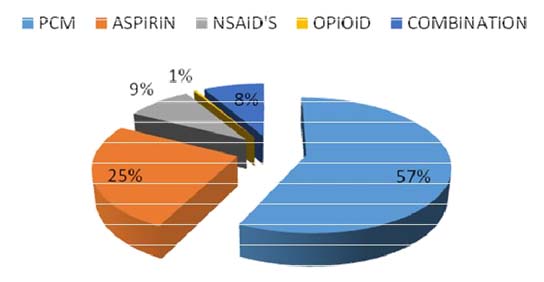
Reasons for self medication and not consulting a doctor were found to be significant cost of visiting a doctor (30%), time consumed (24%), difficulty in getting appointments (20%) and ease and convenience of buying medication at nearby pharmacy (11%).
Chemists were found to be major source of information (64%), followed by advice given by friend/relative/neighbour (14%), previous doctor’s prescription (12%) and internet (4%) [Table/Fig-3].
Source of information for self medication.
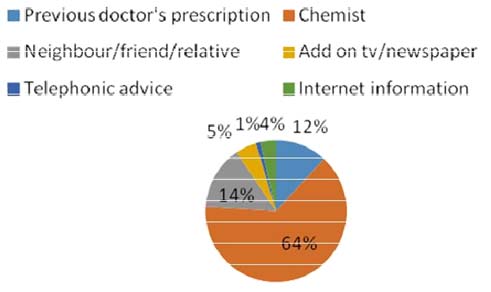
Majority of the buyers (65.4%) were not aware about any kind of side effects of the analgesics. Among rest who were aware, 66% of the consumers were educated on their previous doctors’ visits, 14% got to know from friend/relative/neighbour, where as only 12% were informed about side effects by chemists [Table/Fig-4].
Source of information of adverse drug reactions.
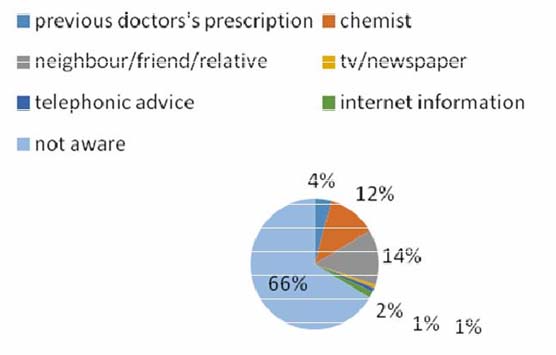
Majority of consumers (74.4%) suggested that they would like to gather information on such drugs using self medication call centres.
Results of the ability to use internet/mobile application and social media show 32% of the consumers to be illiterate, 8% class 5, 11% class 8, 49% had received education matriculation and above [Table/Fig-5].
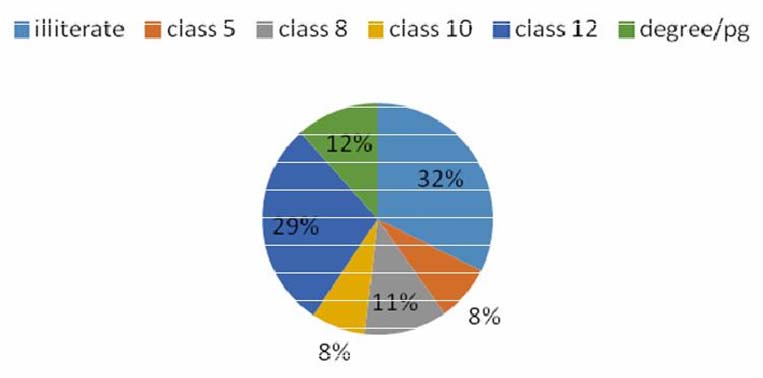
Among the study population 56% of the consumers were not able to use internet and rest 44% were found to be internet friendly. Language used for internet was found to be English (28%), Hindi (12%), both English and Hindi (3%) and regional in (1%) [Table/Fig-6].
Language used for internet.
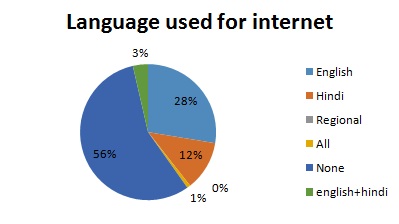
Discussion
Results of our study show that among all the self prescribed analgesics paracetamol is used most frequently followed by aspirin and other NSAIDs.
In a study by Jaiswal S et al., paracetamol was the most common self medication drug. Although considered safest analgesic, this study reported 39% incidence of side effects with this drug [7].
Similar findings were observed in a study conducted in Nigeria regarding patient’s attitude toward analgesic use, where paracetamol was found to be most commonly used analgesic. Authors also reported its inappropriate use for conditions like tiredness and lack of sleep [11].
Results of our study show that 6.2% of the consumers of self medicated analgesics were elderly. Co-morbid illness was found to be present in 9.6% of the consumers. Simultaneous consumption of other drugs and occasional drinking was seen in 11.4 % and 15.2% of the consumers respectively. All these factors can lead to development of side effects with the consumption of analgesics. Elderly patients are also more likely to have associated medical diseases like diabetes mellitus, hypertension, cardiac and renal disease. Use of NSAIDs may lead to fluid retention, systemic hypertension and electrolytic disorders. In renal failure patients, NSAIDs may worsen glomerular filtration rate. There is an increase in the risk of bleeding [12,13].
Literature review shows that concomitant use of alcohol and NSAIDs can lead to increase in bleeding time [14,15]. Heavy alcohol consumption increases the risk of liver toxicity associated with paracetamol use [16].
The usage of self prescribed analgesics among pregnant and children were 1.2% and 5.2% respectively. NSAIDs use during early pregnancy can lead to miscarriage and malformations. Usage in third trimester can cause pre-mature closure of ductus arteriosus [17]. Children are at risk of dose related hepatotoxicity with paracetamol [18].
Paracetamol use during pregnancy and in infancy is associated with an increased risk of developing asthma [19-21].
This study shows that chemists are the major source of information for the purchase of these drugs whereas previous physician visits are the major source of information about the related adverse effects.
Previous doctor’s advice was found to be the most important source of information in earlier studies [7].
In our study we found that the consumers do not visit doctor due to high cost, time consumed, and difficulty in getting appointments and ease and convenience of buying medication from pharmacy shops.
In a community based study done in outskirts of Chennai, main reasons for not going to doctor were found to be lack of time, less availability of physicians, more number of medical shops, easy availability of drugs, lack of money and fear of undergoing lab investigations [22].
Knowledge of the side effects was found to be extremely poor. Similar findings were observed in previous study where 79% of the study population was ignorant about adverse effects of the analgesics [23].
Majority (64%) of the consumers in our study were found to rely on pharmacist’s advice. Majority of the chemists do not explain the side effects due to lack of time [24].
In a study done among shopkeepers of retail pharmacies, only 48% had degree/diploma in the field of pharmacy [25].
When asked about the preferred source of information, majority of the consumers suggested call centres. There are potential disadvantages of call centres as setting up a call centre would require very high maintenance in the terms of infrastructure, man-power, and strong networking system. In addition, there is a risk of communication bias.
A study on first of its kind drug and therapy information centre in Germany shows that it helps in better participation of patients in their own health care, reduces problems with drug information and reduces health care visits [26].
Literature suggests that the major factor affecting the pattern of self-medication is education [27,28].
In our study, 49% of the consumers are educated to matriculation and above.
A study done by Koo K et al., on patient education level and utilisation of internet shows positive correlation between education level and ability to use internet for orthopaedic consultations [29]. We found 44% of the consumers to be internet friendly. They use mobile internet for various purposes like whatsapp/Facebook, obtaining information available on various websites, online shopping, booking a taxi/movie ticket. Our study shows strong correlation of education level and ability to use internet/mobile based apps along with inverse relation of education level and ability to use internet/mobile based apps to age, we infer our population to be more internet friendly in near future.
Although online information about health related issues raises concerns about doctor patient dynamics. Studies show that internet use for health related information is increasing especially in younger age group (31-50 years). It is a convenient source but reliability is a concern [30,31].
In a study on evaluation of drug information in internet news group, it was found that 19.4% of the information can be potentially harmful [32].
Benefits of online information were shown in a study by Iverson SA et al., that it helps in engaging the patient in self health care; patients are more likely to follow doctor’s advice and also are able to do necessary dietary changes [33].
Based on findings of our study, we recommend use of website/mobile apps as potential source of information as it will be of low maintenance for the government, bias free as information will be provided by experts. Also this mobile applications/website would provide an authentic and standardised source of information for the general population.
Limitation
Limitations of our study include use of convenient sampling method which may not completely represent the population of the specified area and some amount of bias created as interviewee was not the actual consumer in all the cases. The population studied may not be representative of the whole country, so a large population based study is required before findings of our study can be utilized.
Conclusion
We observed a large number of consumers could be at risk of developing side effects of the self-prescribed analgesics. The awareness about the side effects is limited. We identified a significant number of consumers to be internet friendly.
Hence, we recommend the use of internet based sources like website/mobile apps for creating awareness about safe use of self-prescribed analgesics among adult population residing in a rural area of Delhi.
Declaration
The research was carried out as STS programme under ICMR.